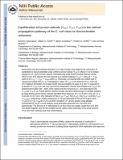Equilibration of Tyrosyl Radicals (Y[• over 356], Y[• over 731], Y[• over 730]) in the Radical Propagation Pathway of the Escherichia coli Class Ia Ribonucleotide Reductase
Author(s)
Yokoyama, Kenichi; Smith, Albert A.; Stubbe, JoAnne; Corzilius, Bjorn; Griffin, Robert Guy
DownloadGriffin_Equilibrium of tyrosyl.pdf (4.306Mb)
PUBLISHER_POLICY
Publisher Policy
Article is made available in accordance with the publisher's policy and may be subject to US copyright law. Please refer to the publisher's site for terms of use.
Terms of use
Metadata
Show full item recordAbstract
Escherichia coli ribonucleotide reductase is an α2β2 complex that catalyzes the conversion of nucleotides to deoxynucleotides using a diferric tyrosyl radical (Y[• over 122]) cofactor in β2 to initiate catalysis in α2. Each turnover requires reversible long-range proton-coupled electron transfer (PCET) over 35 Å between the two subunits by a specific pathway (Y• over 122] [arrows facing left and right] [W[subscript 48]?] [arrows facing left and right] Y[subscript 356] within β to Y[subscript 731] [arrows facing left and right] Y[subscript 730] [arrows facing left and right] C[subscript 439] within α). Previously, we reported that a β2 mutant with 3-nitrotyrosyl radical (NO[subscript 2]Y[superscript •]; 1.2 radicals/β2) in place of Y[• over 122] in the presence of α2, CDP, and ATP catalyzes formation of 0.6 equiv of dCDP and accumulates 0.6 equiv of a new Y[superscript •] proposed to be located on Y[subscript 356] in β2. We now report three independent methods that establish that Y[subscript 356] is the predominant location (85–90%) of the radical, with the remaining 10–15% delocalized onto Y[subscript 731] and Y[subscript 730] in α2. Pulsed electron–electron double-resonance spectroscopy on samples prepared by rapid freeze quench (RFQ) methods identified three distances: 30 ± 0.4 Å (88% ± 3%) and 33 ± 0.4 and 38 ± 0.5 Å (12% ± 3%) indicative of NO[subscript 2]Y[• over 122]–Y[• over 356], NO[subscript 2]Y[• over 122]–NO[subscript 2]Y[• over 122], and NO[subscript 2]Y[• over 122–Y[• over 731(730)], respectively. Radical distribution in α2 was supported by RFQ electron paramagnetic resonance (EPR) studies using Y[subscript 731](3,5-F[subscript 2]Y) or Y[subscript 730](3,5-F[subscript 2]Y)-α2, which revealed F[subscript 2]Y[superscript •], studies using globally incorporated [β-[superscript 2]H[subscript 2]]Y-α2, and analysis using parameters obtained from 140 GHz EPR spectroscopy. The amount of Y[superscript •] delocalized in α2 from these two studies varied from 6% to 15%. The studies together give the first insight into the relative redox potentials of the three transient Y[superscript •] radicals in the PCET pathway and their conformations.
Date issued
2011-10Department
Massachusetts Institute of Technology. Department of Biology; Massachusetts Institute of Technology. Department of Chemistry; Francis Bitter Magnet Laboratory (Massachusetts Institute of Technology)Journal
Journal of the American Chemical Society
Publisher
American Chemical Society (ACS)
Citation
Yokoyama, Kenichi, Albert A. Smith, Bjorn Corzilius, Robert G. Griffin, and JoAnne Stubbe. “Equilibration of Tyrosyl Radicals (Y356•, Y731•, Y730•) in the Radical Propagation Pathway of the Escherichia coli Class Ia Ribonucleotide Reductase.” Journal of the American Chemical Society 133, no. 45 (November 16, 2011): 18420-18432.
Version: Author's final manuscript
ISSN
0002-7863
1520-5126